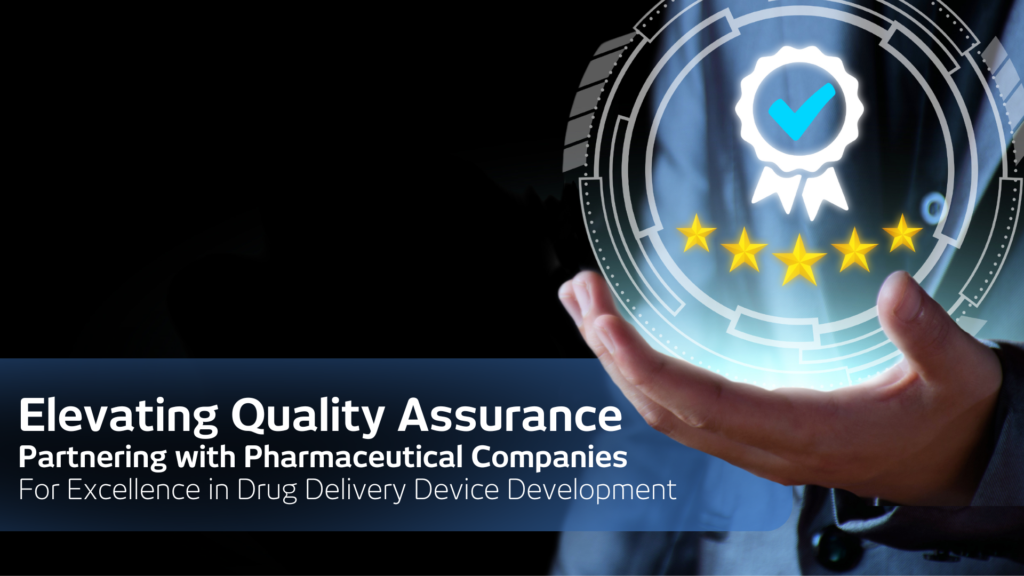
In the rapidly evolving landscape of medical device development, Quality Assurance (QA) remains the cornerstone of reliability and patient safety. For developers of drug delivery devices, adhering to rigorous quality standards extends beyond regulatory obligations—it is a commitment to excellence with direct implications for the wellbeing of patients around the globe. By embracing stringent QA practices and cultivating strong collaborations with pharmaceutical company partners, the industry can attain better clinical outcomes, mitigate risks, and foster continual technological advancement.
Close Collaboration and the Changing QA Landscape
Partnerships between device developers and pharmaceutical companies is re-shaping QA strategies. Together, these stakeholders face a dynamic range of challenges, from shifting regulatory mandates to the integration of cutting-edge technologies and robust risk management approaches. By combining resources and sharing expertise, they can refine manufacturing processes, streamline compliance, and champion a culture of ongoing improvement—all in pursuit of reliable drug delivery devices rooted in consistent quality.
The Journey of Drug Delivery Device Development and Manufacturing: Challenges and Opportunities for QA
Meeting safety, efficacy, and reliability standards is a moral duty as well as a regulatory requirement. In auto-injectors and other drug delivery devices—where precision is vital—QA exerts a pivotal influence throughout the product lifecycle:
- Design and Development: Meticulous designs combined with strong traceability processes ensure medications are delivered safely and accurately.
- Regulatory Compliance: Thorough, well-documented procedures—shaped by regulatory authorities—help achievement of effective audits and secure regulatory approvals.
- Risk Management: Ongoing assessments and targeted testing uncover potential challenges early, allowing for risks prevention and/or timely resolutions.
- Manufacturing Excellence: Validated processes, test methods and tightly controlled production environments uphold consistent quality.
- Skilled and Trained Personnel: Comprehensive, risk-based training equips each team member to fully understand their role, reducing the likelihood and impact of errors.
- Post-Market Surveillance: Continuous monitoring facilitates swift action against emerging issues, protecting device integrity and patient safety.
Even in light of such activities, advancing QA in drug delivery device development still presents a number of challenges
- Evolving Regulatory Landscape: Shifts in regulations—both local and global—necessitate proactive compliance strategies, requires not only monitoring new regulations but also adapting internal processes, updating documentation, and training staff to maintain high standards of compliance across all markets.
- Technological Innovations: The introduction of next-generation technologies requires significant updates and adjustments in company processes, methodologies, and standards. This includes enhancing internal knowledge, expertise, and the continuous training of staff to stay ahead of emerging technologies.
- Global Supply Chain Management: Worldwide procurement requires robust qualification and monitoring systems to ensure suppliers meet quality standards. Ongoing performance assessments and risk management help mitigate disruptions, while strong partnerships ensure transparency, consistency, and a shared commitment to quality throughout the supply chain.
- Cross-Functional Coordination: Effective collaboration between various departments reduces communication gaps and errors. By fostering a culture of shared responsibility and transparent communication, teams can ensure seamless workflows, faster problem-solving, and alignment on quality goals across the organization.
- Strategic Planning: Effectively balancing comprehensive QA procedures with tight project deadlines requires careful strategic oversight, effective resource management, and a steadfast commitment to maintaining compliance with regulatory standards throughout the process.
A Path to Quality Excellence
As the complexities of drug delivery device development continue to grow, maintaining a robust and adaptive QA function is more essential than ever. From core responsibilities to more extensive roles overseeing both development and commercial processes, it is clear that a dedicated and knowledgeable Quality Department is essential. As Elcam Drug Delivery Devices (E3D) has introduced new device platforms and product lines, each with its own regulatory and quality demands, the need for a specialized QA function has been re-affirmed.
By strategically recruiting experts with diverse skill sets, E3D has established a cohesive Quality Department devoted to refining processes and meeting evolving industry standards. Demonstrating the significance of teamwork and a commitment to continuous improvement, united group, guided by a collective vision for excellence, continues to drive progress and adaptability in E3D’s QA function.
Our Quality Management System (QMS) enables processes which are tailored to each device’s unique requirements while upholding compliance, operational continuity, and effective collaboration. Although this independent QMS approach involves navigating potential hurdles, the unwavering determination across E3D’s QA team paves the way for stronger outcomes and sustained growth.
Strategies for Quality Excellence and Regulatory Compliance
Pharmaceutical companies and device developers can sustain and enhance their QA performance through shared strategies, including:
- Collaborative Development Process: Involve the right teams early; set clear milestones and maintain transparent communication.
- Regulatory Strategy: Consolidate submission schedules and documentation for a streamlined compliance approach.
- QMS Integration: Align quality systems across development, production, and post-market phases for consistent oversight.
- Risk Management: Conduct thorough, ongoing assessments to minimize failures in drug-device combination products.
- Continuous Communication & Feedback: Keep discussions flowing through established escalation routes, ensuring rapid resolution of any arising issues.
At E3D, Quality Assurance is more than just regulatory compliance—it is the cornerstone of our mission. By continually enhancing our QA capabilities and fostering close collaboration with our pharmaceutical partners, we are committed to delivering innovative, reliable drug delivery solutions. As the QA Director of E3D, and on behalf of our entire QA team, I can confidently say that our unwavering commitment to quality not only protects patient health across the globe but also cultivates lasting, trusted partnerships within the pharmaceutical industry.
